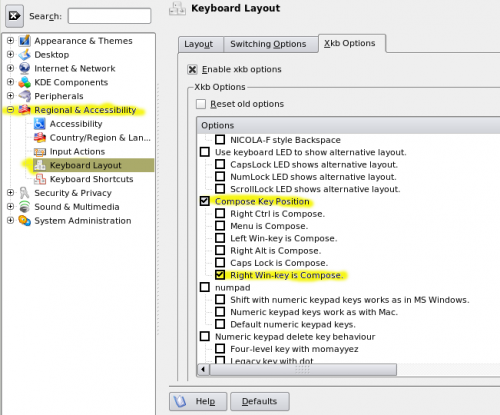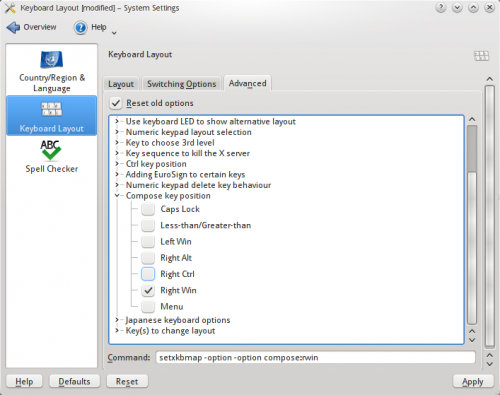Tutorials/ComposeKey/de: Difference between revisions
Translated part 7 into German |
Translated part 8 into German |
||
| Line 16: | Line 16: | ||
=== Konfiguration über das Terminal === | === Konfiguration über das Terminal === | ||
Um dies richtig zu tun, werde ich versuchen den "ganzheitlichen" Weg über das Terminal zu gehen: | |||
* Reconfigure the console for the used keyboard, and the character encoding. Do this in a text terminal or the console. | * Reconfigure the console for the used keyboard, and the character encoding. Do this in a text terminal or the console. | ||
Revision as of 13:29, 10 October 2010
Die Verwendung / Konfiguration der Compose-Taste
Einleitung
Die Compose-Taste wird verwendet um Zeichen auf der Tastatur zu tippen, die normalerweise nicht verfügbar sind. Solche Zeichen können "Umlaute", ein "Längezeichen" oder Akzente auf Buchstaben werden:
Diese Beschreibungen wurden auf einigen Kubuntu Hardy Heron 8.04.1 Systemen getestet. Weitere Informationen finden Sie in dem Abschnitt Verknüpfungen und weitere Informationen unterhalb.
Die Änderungen werden unter (fast) allen Anwendungen, einschließlich der Arbeitsflächenumgebung, Browser, OpenOffice.org, sowie viele Konsolen / Nur Text-Anwendungen, funktionieren.
Die folgenden Anweisungen werden eine Compose-Taste einrichten, die auf die rechte Logo-Taste gelegt wird (auf den meisten Tastaturen ist dieses Logo das Windowslogo).
Konfiguration über das Terminal
Um dies richtig zu tun, werde ich versuchen den "ganzheitlichen" Weg über das Terminal zu gehen:
- Reconfigure the console for the used keyboard, and the character encoding. Do this in a text terminal or the console.
$ sudo dpkg-reconfigure console-setup
- Follow these steps in the configuration:
- Choose your keyboard (here a default 104 US keyboard)
- If you want the !AltGr key replacement, choose one
- Choose which key you would like your compose key to be mapped to. I use the right logo key.
I'd much rather like to use the left logo key, but that's not available in the console setting. But in the graphical window environment (KDE Plasma) that is possible.
- Choose the console's encoding, set it to UTF-8
- Choose what character set should be available on the console. I use Combined - Latin; Slavic Cyrillic; Hebrew; basic Arabic
I guess that selection should give me the wanted characters.
- Choose what type of console output you'd like (do whatever you like, to be safe you can go with the given current defaults)
- A new initial RAM disk for the next boot will be created now.
KDE 3.x Configuration
Now we can go on and configure our windowing environment. This description uses either Kcontrol or the Kubuntu configuration tool, which exposes the same option dialogue.
- Start the System Settings or the KDE Control Center
- (for System Settings) or (for Control Centre) ->
- Choose your keyboard layout
- Modify the <menuchioce>Xkb Options</menuchioce> to select/enable the compose key

KDE SC 4.x configuration
Now we can go on and configure our windowing environment (Plasma). This description uses the System Settings as they're available in the K-Menu of the Kubuntu install:
- Start the System Settings
- Select the <menuchoice>Keyboard Layout configuration
- Under the Layout tab, select
- Modify Advanced options to select/enable the compose key

Configuration for Gtk Applications (Gnome, FireFox, etc.)
Gtk (such as also FireFox) and Gnome applications use (on an Ubuntu system) usually SCIM as the input method, not XIM (X Input Method) that relies on the configurations from (X)Compose. Therefore, you will often find that the "a" and "o" macron characters can yield the female/male ordinals "ª" and "º". To still make it work, Gtk applications need to be "told" to use XIM instead.
"One Off" Configuration
For a single application you can do it by just setting the environment variable GTK_IM_MODULE for the application to be launched to xim:
$ GTK_IM_MODULE=xim firefox
More permanently that can be done for a single shell session like this:
$ export GTK_IM_MODULE=xim
This can, of course, also be persisted for a single user in your ~/.bash_profile, or for all users in /etc/environment. This is, however, the less elegant way, the more elegant way follows below.
Persistent Configuration
- Copy the setup file /etc/X11/xinit/xinput.d/default to /etc/X11/xinit/xinput.d/xim
$ sudo cp /etc/X11/xinit/xinput.d/default /etc/X11/xinit/xinput.d/xim
- Edit the file /etc/X11/xinit/xinput.d/xim and set the input method for GNOME and KDE to xim
... GTK_IM_MODULE=xim QT_IM_MODULE=xim ...
- Create a link for the locale all_ALL (or the desired locale only):
$ sudo ln -sf /etc/X11/xinit/xinput.d/xim /etc/X11/xinit/xinput.d/all_ALL
If you are using a Debian-derived distribution use following instead
$ sudo update-alternatives --verbose --install /etc/X11/xinit/xinput.d/all_ALL xinput-all_ALL /etc/X11/xinit/xinput.d/xim 20
- After a restart of the X server everything should work.
Optional Tweaking of XCompose Map
Now that you're using XIM, you can further tweak the XCompose input map for further characters, or for characters in more convenient locations, etc.
To do that follow these steps:
- Create a ~/.XCompose file, and put the following lines into it:
# ~/.XCompose # This file defines custom Compose sequences for Unicode characters # Import default rules from the system Compose file: include "/usr/share/X11/locale/en_US.UTF-8/Compose" # To put some stuff onto compose key strokes: <Multi_key> <minus> <greater> : "→" U2192 # Compose - > <Multi_key> <colon> <parenright> : "☺" U263A # Compose : ) <Multi_key> <h> <n> <k> : "hugs and kisses" # Compose h n k <Multi_key> <less> < p> : "< p>" # Compose < p
- Just log out and in again (no restart necessary), and you can use your new "multi key short strokes" using the compose key to your desire. As you see this even works for creating longer character sequences.
Typing Macrons, Umlauts, Accents, ...
The compose key will be now whatever you have configured it to be, e. g. right logo.
- Macrons
compose + shift + hyphen then <vowel >or
compose + underscore then <vowel >-->
āēīōū ĀĒĪŌŪ
- Umlauts
compose + shift + <single quote> then <vowel >or
compose + <double quotes> then <vowel >-->
äëïöü ÄËÏÖÜ
- The German Ess-Zet ligature
compose then s and s (twice the "s")
-->
ß
- More bindings can be found in /usr/share/X11/locale/en_US.UTF-8/Compose
Links and Further Information
- http://cyberborean.wordpress.com/2008/01/06/compose-key-magic/
- http://ubuntuforums.org/showthread.php?t=209115
- http://www.seedwiki.com/wiki/takomapark/compose2
- http://wiki.linuxquestions.org/wiki/Accented_Characters
- http://people.uleth.ca/~daniel.odonnell/Blog/custom-keyboard-in-linuxx11
- http://hdante.blogspot.com/2007/05/kiel-oni-skribas-typing-esperanto.html
